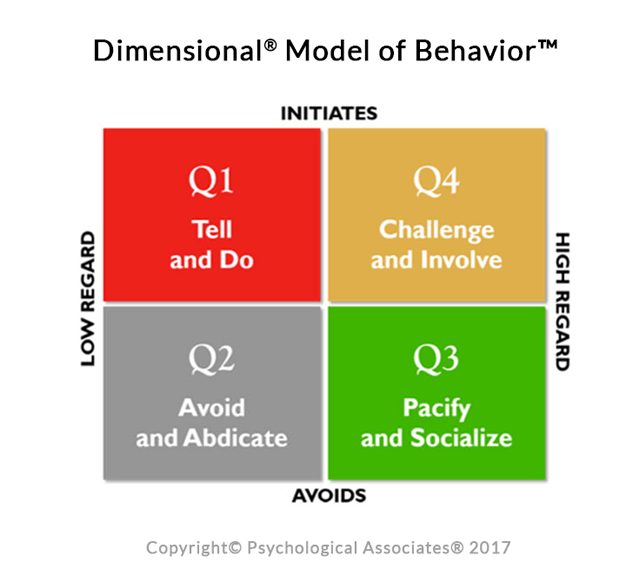People Can Be a Challenge to Work With
Do you work with a difficult person? Ask this question in any office, and everyone will tell you that they have at some point. This leads to a second, tougher question. How to communicate effectively and handle difficult people?
The answer is complicated in that not all difficult coworkers are the same. They may display a variety of different workplace behaviors, which means there is no one single method or approach for dealing with a difficult colleague. The key to developing the right approach to deal with a difficult coworker is to understand that person’s unique behavioral style.
First we’ll discuss our Dimensional Model and its four different types of behavior. Then we’ll discuss how to communicate effectively with each.
Dimensional Model of Behavior
How do you identify a person’s behavioral style? Or, said differently, how do you determine what kind of “difficult” this person is? We invite you to check out our Do You Work for a Difficult Person Behavioral Questionnaire. You’ll find out how to communicate effectively and handle the difficult people you deal with.
We’ve found that there are two primary dimensions of behavior, one that is related to regard for others’ thoughts, feelings, and inputs, and one related to the level of engagement with the task at hand. If you can map the difficult person’s behaviors along these two dimensions, you can begin to understand the overall behavioral style.
Using this Model, we see three patterns, or “types,” of difficult behaviors and one pattern that embodies the preferred behavioral style.
The Hostile or Arrogant Type
(Q1). This person shows little regard for other’s feelings. Q1 might be abrupt and use harsh criticism in the workplace, or might come off as haughty and self-important. This person often gets the immediate job done — but everyone dislikes this person afterwards.
The Reluctant Type or the “Slow Mover”
(Q2). Low in regard and engagement, this person is nearly impossible to motivate. Q2 tends to be overly cautious, quick to pass the buck, and unwilling to stick out his/her neck. Managers of this type tend to say “no” to everything, even in the face of compelling reason.
The Overly Social Type
(Q3). This person is often well-liked; friendly and open; and might even be the “office butterfly,” flitting from person to person and sharing gossip. Though Q3 has regard for what others think, this individual is not particularly motivated by the work — so socializing tends to take over. This can be taken to an annoying extreme, especially when focus and follow-through are lacking.
The fourth type of person is not really difficult at all: Q4 demonstrates the right level of engagement and regard for others.
How to Communicate Effectively with Different People?
Whether a manager, a team member, or just a cubicle mate, identifying the type of person you work with — difficult or not — allows you to vary your communication approach. For example:
- Q1 types are very goal-oriented and independent, thriving on a sense of accomplishment. When communicating with them, explicitly state the purpose of the conversation and stick to the tasks at hand. Engage them by asking for their help or opinions.
- Q2 types are wary of change and dislike disruption. Present tasks as ways of avoiding a risky state of affairs. Being well prepared will be better received than spontaneity. Challenge Q2 coworkers to come up with their own ideas and solutions. Be sure to state clearly What’s In It For Them (or WIIFT)!
- Q3 types are social and have a need for acceptance. Leverage this need to keep them focused. Allow them to socialize, but make it clear when this is interfering with your work. Simply knowing that they have “crossed a line” can be enough to get Q3 types to change their habits.
What you’ll find, over time, is that the person who, at first, appears difficult or confrontational is actually just working from a different set of goals, fears, and needs. Understanding the other person’s perspective puts “difficult” behavior in a new light.
And, sometimes, those people can become our greatest teachers. You simply have to have the right perspective. Then you can work with difficult people more effectively.
Which behavior types do you work with? We hope we’ve armed you with some good strategies for how to communicate effectively and deal with difficult people. For more information, check out our Q4 Leadership: The People Skills Advantage Workshop. And please enjoy additional blog posts by Dr. Hal Guterman.













